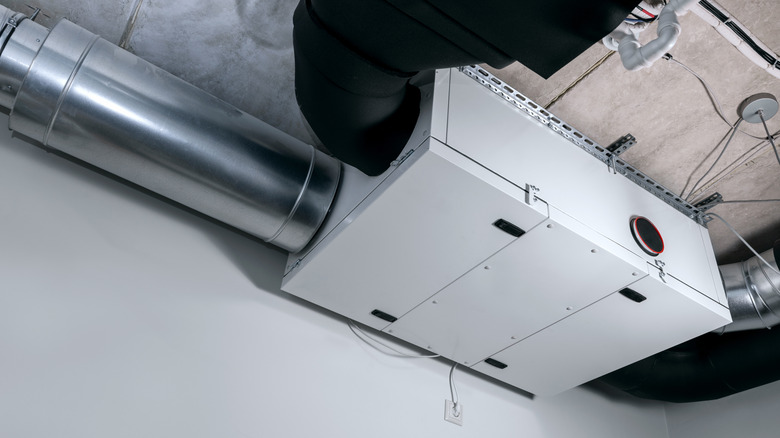HRV Or ERV? Mike Holmes Explains Which Air System Is Best For Your Home
Today's homes are built to be pretty much airtight. While that's fantastic for keeping outdoor pollution from sneaking into your home, it also keeps bad indoor air trapped. And if you're thinking indoor air pollution can't be that bad, think again. According to the Environmental Protection Agency, the air inside our homes could be more contaminated than the air in big, busy cities. Yuck. Luckily, Mike Holmes, host of HGTV's Holmes on Homes, has a straightforward solution to improve your home's air quality: Install an energy or heat recovery ventilator.
"The quality of the air inside our homes plays an important role in how we feel day by day..." Holmes says in a post on his website. "My number one way for properly creating an efficient air exchange is by installing a heat recovery ventilator, or even better, an energy recovery ventilator." These mechanical ventilation systems cycle stuffy air out and bring fresh air in while keeping your home comfy. But how do you know which air system is right for your home? It depends on a few factors, but the most notable is your location.
What's the difference between an ERV and HRV?
If your home feels stuffy, the best way to solve it is to install an air system, but which one? Let's dive into what makes them different. While heat recovery ventilators (HRV) and energy recovery ventilators (ERV) provide the same level of ventilation, they use separate methods. HRVs are designed to move the heat from expelled air to inbound air, which keeps the temperature stable without adding or removing any moisture. This is ideal for homes located in areas with longer and/or more intense winters.
On the other hand, ERVs control both the heat and moisture in the air to keep it at a comfortable temperature and humidity while cycling fresh air through your home. Because ERVs are designed to handle the damp, they are the perfect choice for homes that experience both winter chill and summer heat, especially the humid ones. This ability to do double duty is one of the top reasons Holmes considers the ERV to be the best option for homeowners.
How to decide which one is right for your home
Once you know the difference between the systems, it's time to decide which one is right for your space. Considering where your home is located and how the air in your home currently feels is a good guide, but don't forget lifestyle and maintenance. For example, if it feels like the humidity levels in your home are too high every time you cook, an ERV might be the right option for you. Or if you can't get rid of the stuffiness, no matter how many windows you open, a HRV may be a better choice.
When it comes to maintenance, ERVs tend to require slightly less maintenance. Both systems need their filters cleaned once a quarter at least and an inspection done annually. HRVs may need additional maintenance to clear away built-up grime and keep them running efficiently — some experts advise checking in twice a year for these systems. During your annual inspection, check the drain pipes, ducts, and any other ventilation to make sure excess water and waste can easily flow out, and take a look at the fans to ensure they're working properly.

